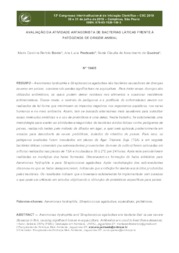Atividade antimicrobiana de bactérias láticas frente a patógenos de origem animal.
Atividade antimicrobiana de bactérias láticas frente a patógenos de origem animal.
Author(s): BONIN, M. C. B.; PENTEADO, A. L.; QUEIROZ, S. C. do N. de
Summary: Resumo: Aeromonas hydrophila e Streptococcus agalactiae são bactérias causadoras de doenças severas em peixes, ocasionando perdas significativas na aquicultura. Para tratar essas doenças são utilizados antibióticos, os quais podem deixar resíduos nos alimentos e ocasionar resistência antimicrobiana. Desse modo, o controle de patógenos e a profilaxia de enfermidades devem ser realizados de tal forma que minimizem os impactos negativos nos organismos aquáticos, nos seres humanos e no meio ambiente. Assim, tem se buscado alternativas mais saudáveis para substituir essas moléculas sintéticas e o uso de probióticos é uma delas. Neste trabalho, foi estabelecida uma metodologia para avaliar as atividades antagonistas de bactérias ácidos láticas contra patógenos de peixes, realizando testes pelo método de difusão em ágar, a qual será aplicada posteriormente em ensaios para descoberta de novos probióticos, isolados de intestino de peixes. Para isso, os patógenos avaliados foram inoculados em placas de Ágar Triptona Soja (TSA) e em seguida bactérias láticas comerciais (ou sobrenadantes provenientes do meio de cultivo) foram colocadas em orifícios realizados nas placas de TSA e incubadas a 35 ± 2°C por 24 horas. Após este período foram realizadas as medições dos halos formados. Observaram-se formação de halos inibitórios para Aeromonas hydrophila e para Streptococcus agalactiae. Após neutralização dos sobrenadantes observou-se que os halos desapareceram, indicando que a inibição foi devido aos ácidos produzidos pelas bactérias. Os resultados indicam que o bioensaio estabelecido foi implementado com sucesso e que pode ser utilizado em estudos objetivando a obtenção de probióticos específicos para peixes. Abstract: Aeromonas hydrophila and Streptococcus agalactiae are bacteria that cause severe diseases in fish, causing significant losses in aquaculture. Antibiotics are used to treat these diseases, which can leave residues in food and cause antimicrobial resistance. Thus, pathogen control and disease prophylaxis should be performed in a manner that minimizes negative impacts on aquatic organisms, humans and the environment. We have sought healthier alternatives to replace these synthetic molecules and the use of probiotics is one of them. In this work, a methodology was established to evaluate the antagonistic activities of lactic acid bacteria against fish pathogens, performing tests by the agar diffusion method, which will be applied later in tests for the discovery of new probiotics, isolated from fish intestines. For this, pathogens evaluated were inoculated in Tryptone Agar Soy (TSA) plates and then commercial lactic bacteria (or supernatants from the culture medium) were placed in holes made in the TSA plates and incubated at 35 ± 2°C per 24 hours. The measurements of the formed halos were carried out after this period. Inhibitory halos were formed for Aeromonas hydrophila and for Streptococcus agalactiae. The halo disappeared after neutralization of the supernatants, indicating that the inhibition was due to the acids produced by the bacteria. The results indicate that the established bioassay was successfully implemented and that it can be used in studies aiming at obtaining probiotics specific for fish.
Publication year: 2019
Types of publication: Paper in annals and proceedings
Unit: Embrapa Environment
Observation
Some of Embrapa's publications are published as ePub files. To read them, use or download one of the following free software options to your computer or mobile device. Android: Google Play Books; IOS: iBooks; Windows and Linux: Calibre.
Access other publications
Access the Agricultural Research Database (BDPA) to consult Embrapa's full library collection and records.
Visit Embrapa Bookstore to purchase books and other publications sold by Embrapa.

